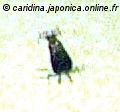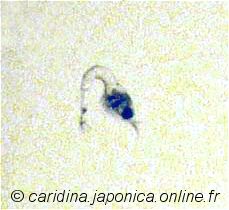 In this photograph you can see the eggs in the abdomen of a female. One can clearly distinguish the tiny black dots, which are the larvae's eyes. When the eggs are like this, it is just a matter of days before they hatch...
In this photograph you can see the eggs in the abdomen of a female. One can clearly distinguish the tiny black dots, which are the larvae's eyes. When the eggs are like this, it is just a matter of days before they hatch...
Freshly hatched zoes !
The hatching usually occurs during the night, and if everything has gone well you should wake up in the morning to find hundreds of small zoes in the hatching tank. The larvae are very tiny dots (in fact tiny 'commas') just slightly bigger than 1mm, floating in the water. But they are not so difficult to spot, thanks to their large number and given a uniform dark or light background. (that's why I use a sheet of cardboard to block out the light over the back of the tank)
Here is a couple of photographs showing what you see after a productive hatch :

 I captured a few zoes a few hours old to take some macro photographs of them. I DIY-ed a lighting system with an electric bulb in order to photograph them against the light, so sorry if the quality of those pictures seems poor to you, but I'm afraid it's the best I can do without a really good macro lens or a microscope. The magnification is grossly 20 times on the following pictures :
I captured a few zoes a few hours old to take some macro photographs of them. I DIY-ed a lighting system with an electric bulb in order to photograph them against the light, so sorry if the quality of those pictures seems poor to you, but I'm afraid it's the best I can do without a really good macro lens or a microscope. The magnification is grossly 20 times on the following pictures :





Now the female that has hatched can be transferred back to the main tank.
After a few days minimum (3 or 4 days), I can siphon the zoes out of the hatching tank, with some plastic air tube, in order to prepare them for the breeding tank. A small tip to help you catch them : the zoes are attracted by light !
To feed, or not to feed?
The newly hatched larvae do not need to be fed during their short stay in freshwater : indeed they will start to grow only when put in salt water, so don't bother feeding them before, all you'll manage to do is pollute the water.
|

